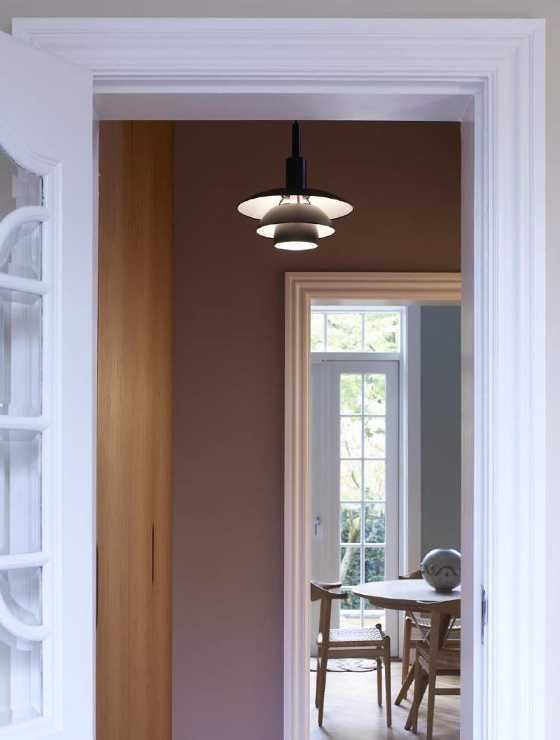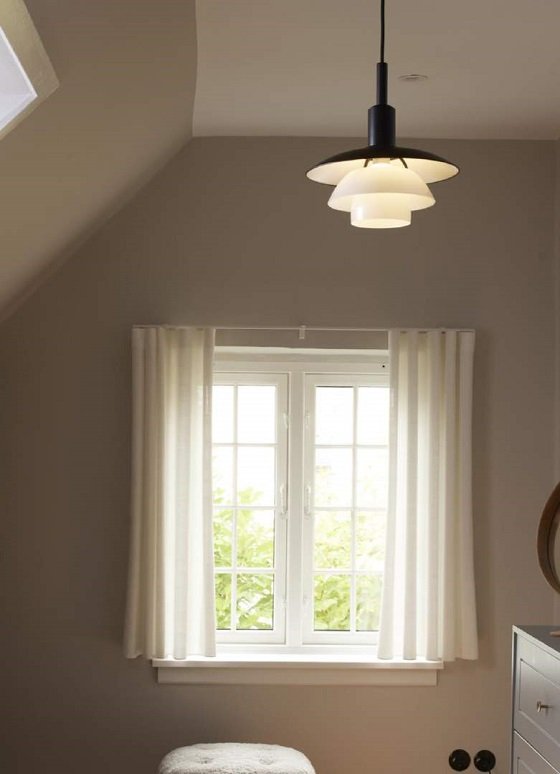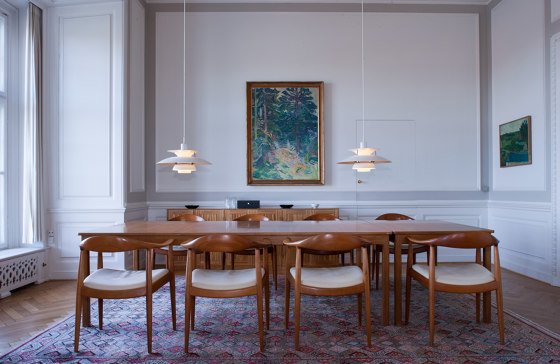On 1st March 2022, Louis Poulsen re-issued the the quintessential PH lamp. This is MASSIVE—for you, because the PH lamps are the most useful lights ever invented. They are:
the most efficient (preventing glare whilst not absorbing light)
the most practical (you could meet the requirements of almost any interior just from the PH lamps that Louis Poulsen currently has in production), and
the most versatile (they fit æsthetically into any style of interior). Think of them as lighting machines..
As a result, they are also iconic—a design statement that flatters your client.
OK, so let's unpick those wild claims!
Nobody has ever (and now ever will) spent so much time and thought developing the perfect luminaires for the incandescent light bulb as did Poul Henningsen ("PH"). As he wrote in June 1927, he set out to "...solve the new task of producing a glare-free light, which would also be economical" (in the sense that none of the light would be wasted by being absorbed by the shade). All important surfaces should be turned downwards to avoid dust accumulation, the filament should be totally obscured by the shades, and it should be possible for the manufacturer to regulate the colour of the light.
So he did not set out produce a pretty light. Instead, he formulated a system that has generated the widest conceivable range of luminaires, all of which fulfil his intentions. PH explained its basis to be the bell shape of all reflector systems, such as the parabolic mirror and the car head lamp. He evolved an arrangement of three shades, the curves of which are logarithmic spirals (so that there is the same angle between the shades and the light rays at every point). Thus, though their dimensions are so different, there is a harmonic transition between them.
He created a rational, modular lighting system in which the size, material and surfaces of the shades could be combined according to purpose. Indeed, the "PH Lamp" is a subset of designs that he was delvoping from 1925 until he could work no longer (and which includes classics such as the Artichoke, Louvre and Snowball). Many of the PH Lamps are currently in production by Louis Poulsen—I count eleven pendants, two wall lights, six table lights and three floor lights, not including the new releases in March 2022. Throughout, we see Poul Henningsen experimenting with the materials used, with the combinations of shades, with inserting coloured elements where they can't be seen so as to modify the light cast, and with different finishes on the undersides of the shades (also to colour the light).
So what is regarded as the quintessential PH lamp is this, issued in June 1926:
The shades are opal glass, because he wanted a version which cast a smaller proportion of the light downwards than did the copper shades he was using before. It is known as a 5/5 (often written as 5-5).
And this is where we must address the naming of the PH Lamp series: Apparently baffling, the principle is really very simple, and the key to understanding these important lights.
Here goes. The shapes of the shades are determined solely by engineering the lght cast. There are three shades, in the proportions 3:2:1. The designations of the models are in two parts. The first part indicates the diameter of the top shade: a "5" is Ø50cm. The second part indicates the size of the lower two shades, given by the size of the top shade from which they are derived. Thus a "5/5" has a top shade that is Ø50cm and the lower two shades are in that proportion of 3:2:1 to a 50cm top shade. But the bottom two shades can be smaller: a "3/2" has a top shade of Ø30cm but the bottom two shades are in 3:2:1 proportion to a "2"—a Ø20cm shade. It's easier to grasp if you can see it:
When all the shades are based on the same dimension (e.g a 5/5 or a 3/3), they are known as "Whole". When they are not (e.g. 4/3, 2/1) they are known as "Odd".
Although the PH5/5 was immediately successful, over the last few decades only Odd versions have been in production. Now you know all this, you can begin to understand the significance of what Louis Poulsen launched on the 1st March. They are bringing back Whole versions—the 5/5 and the 3/3. Here they show the difference in size between the 3/3 and the 3/2:
Which to use? We know by now that it is not a case of which is prettiest (though some feel that Odd versions seem lighter and more elegant), but of what light distribution is required.. A Whole configuration works better close to the ceiling, whereas an Odd configuritoni is better low over a table, where more appropriate light is cast when the top shade is larger than the lower two.
The March releases are made of black metal shades (that are white underneath), white glass shades, or a mix f the two:
They've designed a nice new ceiling rose to go with them:
But, as I say, the "PH lamp" is only a subset of the whole gamut of lights designed by PH that use the same principles. There were street lights, dentists' lights, operating table lights, sports hall lights.... .Actually, sports halls were particularly difficult to light before strip lights, because players often have to look upwards, and it is essential that they don't get blinded by glare. .Where several sports are played, a solution is all the more difficult: you could arrange lights to suit tennis players, but if badminton is played in the same hall, the court is often laid out across the tennis court, at 90º to it. Poul Henningsen used his system to overcome these problems: his Tennis Lamp is seen here in Copenhagen's KB Hall in 1994:
The most popular version of PH Lamp now is a 4-shade lamp—the PH5, designed in 1958: No-one expected then that it would become the most popular of all his lamps.
Louis Poulsen have done a wonderful job keeping PH5 fresh, bringing out versions in a wide rage of colours:...
...and there are lots of images of them looking wonderful (and practical) in a variety of differing spaces in our LIGHT FINDER (click here, put 2006591 in the search box, click on any of the PH5s and then on "Image gallery").). For example:
and they are uniquely well-suited to being a bedside pendant because—remember—no glare, even when you look up into them!
The trumpet-like fourth shade is designed to spread light more widely, and thus cast ambient light. It has been criticized for not being in harmony with the three lower shades—it appears to be the wrong way up (in spite of the fact that it is created on the same logarithmic spiral). But PH liked it best, because it most closely met his criteria: an illuminated area below, plus a soft, dimmer light extending to the walls.
So sound are PH's principles that Louis Poulsen produced posthumously the PH80 in 1974, so called because it was the 80th anniversary of his death. It is a hybrid: the 3-shade system with a tiny 4th shade. They are also offering black and white versions of this floor light amongst their March 2022 launches:
There are lots more they could re-issue. I think the table light created for the Hotel Marina...
...would be brilliant as a cordless light! It was designed so that the sandwich tray could be placed on top of it. This is iimportant because, though there are lots of cordless lights that are designed to go in the centre of tables, they all take up space, where ideally you'd have your dim sum baskets, tapas plates &c. Here are some guys and gals having a good time in the Hotel Marina:
Poul Henningsen was fiercely intelligent and turned his mind to many things other than lighting, including designing buildings and furniture, making films and writing film scripts. He was an outspoken journalist and anti-fascist polemicist, incurring the wrath of the Nazis.
Anorak fact #1: he escaped to Sweden in a rowing boat, accompanied by Arne Jacobsen and their wives.
Anorak fact #2: he designed a see-through piano!
And not just a one-off!! You can buy one today at the PH Piano showrooms in Copenhagen (where they also sell PH furniture—click here). Click here to see and hear one being played.
Because there are so may PH options, they take a little navigating, so do get in touch if you'd like us to work with you to determine exactly which models and specifications would be most suitable for your project.
























